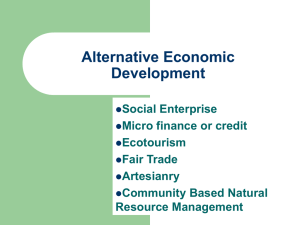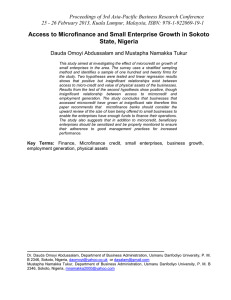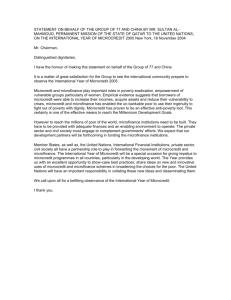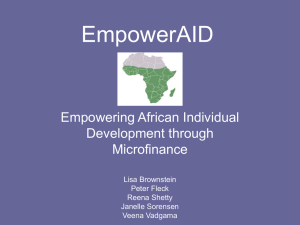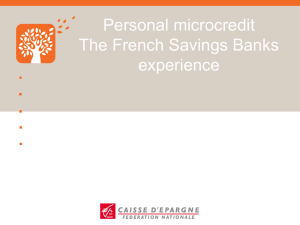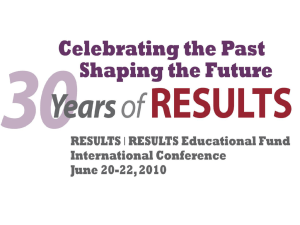eurship n Microcredit and Entrepre
advertisement
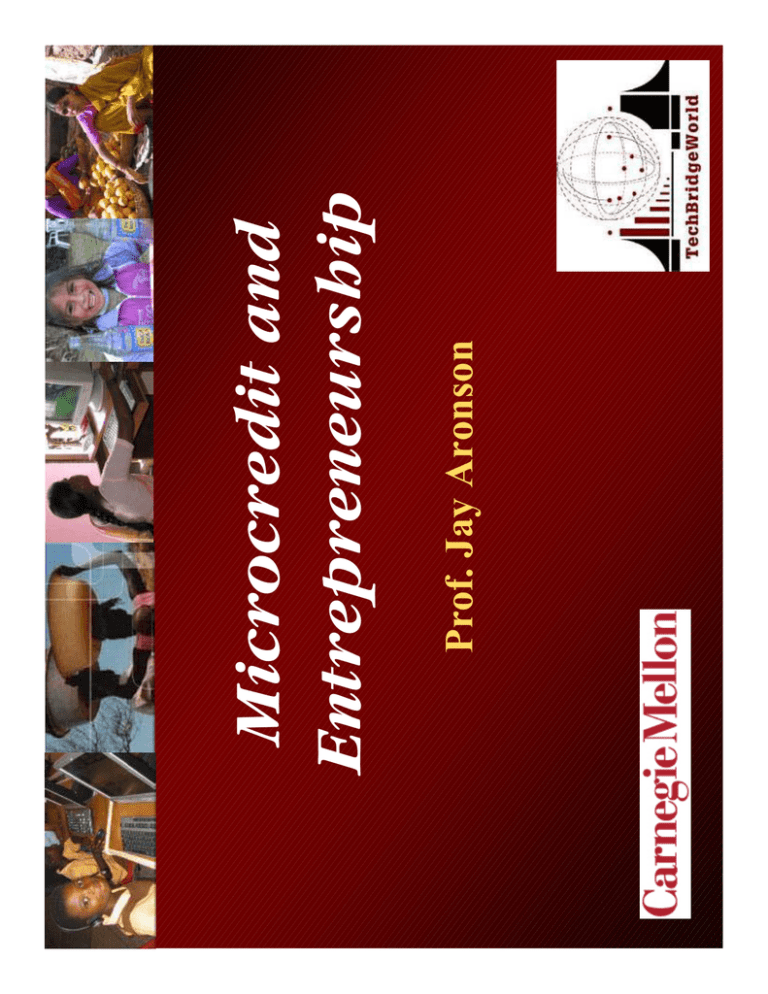
Prof. Jay Aronson Microcredit and Entrepreneurship 2 ! Microcredit has become a development buzzword, just like “human capacity” or “sustainability” ! 2005 was dubbed the “International Year of Microcredit” by the UN ! A search of “microcredit” on Google yields 2.7 million hits ! Mohammed Yunus and Grameen Bank won the 2006 Nobel Peace Prize ! Profit seekers are starting to enter the microfinance sector (MNC banks, regional banks, etc.) Buzzzzzzzzzzzzzz 3 ! Microfinance: loans, savings, insurance, transfer services and other financial products targeted at low-income clients. ! Microcredit: small loan to a client by a bank or other institution. ! Microsavings: deposit services allowing storage of small amounts of money for later use (e.g., unexpected expenses or future investment), many have no minimum balance requirements ! Microinsurance: system by which people, businesses and other organizations make a small payment to share risk. The World of Micro… 4 The incentive to repay is based on peer pressure; if one person in the group defaults, the other group members make up the payment amount. » Source: International Year of Microcredit ! Individual lending, focuses on one client and does not require other people to provide collateral or guarantee a loan ! Lots of different lending models—Grameen is only one type • number of individuals to provide collateral or guarantee a loan through a group repayment pledge. Two main types of microcredit ! Group lending, or solidarity lending, allows a 5 • Source: Grameen Bank Info “Microcredit” page 1. Traditional informal microcredit (such as, moneylender's credit, pawn shops, friends and relatives, etc.) 2. Microcredit based on traditional informal groups 3. Activity-based microcredit through conventional or specialised banks (such as, agricultural credit, livestock credit, fisheries credit, handloom credit, etc.) 4. Rural credit through specialised banks. 5. Cooperative microcredit 6. Consumer microcredit 7. Bank-NGO partnership based microcredit 8. Grameen type microcredit or Grameencredit Varieites of microcredit 6 ! ! ! ! ! ! ! ! ! ! • Source: Grameen Bank Info “Microcredit Page” Promotes credit as a human right. It is targeted to the poor, particularly poor women. No collateral, or legally enforceable contracts. It is based on "trust", not on legal procedures and system. Promotes income generation, not consumption Created in oppostion to traditional banking practice People should not go to the bank, bank should go to the people. Group-lending based approach It comes with both obligatory and voluntary savings programs for the borrowers. Sustainability of business model is key Grameencredit gives high priority on building social capital. Grameen Credit 7 ! Sources for video: ! http://www.youtube.com/watch?v=s3I9ThV ww3k ! http://www.grameenfoundation.org/video/ful lscreen.html Microfinance Video 8 » Source: International Year of Microcredit ! When conditions pose severe challenges to loan repayment (e.g., high disease burden, geographic isolation, business communities, famine, natural disaster, war, etc.) ! According to most microcredit sources, under these conditions, more traditional development techniques work better ! In general, clients must have the capacity to repay the loan under the terms by which it is provided in order for loans to be effective When is microcredit NOT appropriate? 9 • • • (source: STATE OF THE MICROCREDIT SUMMIT CAMPAIGN REPORT 2005) 3,164 microcredit institutions 92,270,289 clients, 66,614,871 of which were were among the poorest of the poor 83.5 percent, or 55,622,406 million, of these poorest people were women ! Grameen, FINCA, Accion International, Opportunity International, Namaste Direct, Fonkoze (Haiti), etc. etc. etc. ! As of December 31, 2004 Many examples 10 • • • • • • Clients can get cash and do other transactions at ATMs without connectivity All account info stored on smart card Security based on fingerprint GUI designed for illiterate users (audio and video) Multilingual High rate of acceptance Prodem Smart ATM in Bolivia Graphic taken from and Insead presentation: “The Myths & The Magic of Microfinance: Assessing the role that microfinance can play in private sector development in Africa,” available online at: http://www.insead.edu/indevor/documents/0606_MF_magicMythl.pdf ! Role of Technology 11 G-Cash: Microfinance by phon 12 ! ! ! Lots of anecdotal evidence and trends, little statistically significant proof Evidence available suggests impact is greatest in poorest communities and families Definitely helps people, but it isn’t clear whether it lifts them out of poverty Grameen, FINCA and a few others are exceptions Not a sure bet for investors—making a profit on microlending is hard! • Most appropriate when household has on-going economic activity and existing cash flow or potential for cash flow" danger of creating large debt burden • • • Very difficult to determine whether microfinance has a significant impact on developing economies Cautions 13 Generally 30-70% per year But that’s much lower than other potential sources I don’t find this convincing, do you? • But what is in the real world? ! Not a solution for the destitute; must work in concert with other efforts • ! Many people argue that the state should be providing microfinance services and a general social safety net • • ! Not all microcredit lenders charge low interest rates Cautions 14 ! Microenterprises require macrosupport to survive ! Creating increased debt burden for poorest of the poor Cautions, cont. 15 – increases likelihood that they will make good use of these goods and services – creates income-generating activities for community members (opportunities for old-fashioned entrepreneurs) – More sustainable than donor-led or government-led programs – Shift from charity and hand-outs to self-improvement and private initiative (again, a part of the neoliberal approach to development) Social entrepreneurship The notion that people in development communities should pay [what they can] for the goods and services that will improve their lives ! Many of the most innovative approaches to development involve all three • • with two other development trends: Links to Entrepreneurship ! The microcredit trend has emerged simultaneously 16 ! ! ! ! Jean Bapiste Say, early 19th century French economist Joseph Schumpeter, early 20th century economist Peter Drucker, 20th century business management guru – Source: Tim Zak (CMU-Australia) Howard Stevenson, Harvard B-School “Entrepreneurial management [is] the pursuit of opportunity without regard to resources currently controlled.” – “The entrepreneur always searches for change, responds to it, and exploits it as an opportunity.” – “Entrepreneurs … reform or revolutionize patterns of production.” – “The entrepreneur shifts economic resources out of an area of lower and into an area of higher productivity and greater yield.” What is an entrepreneur? 17 • Generally with the goal of decreasing reliance on traditional sources of solutions (I.e., government, philanthropy, and corporations) ! Applying the principles and practices of entrepreneurship to social problems What is social entrepreneurship? 18 ! Adopting a mission to create and sustain social (not just private) value ! Recognizing and relentlessly pursuing new opportunities to serve that mission ! Engaging in a process of continuous innovation, adaptation, and learning ! Acting boldly without being limited to resources currently in hand ! Exhibiting a heightened sense of accountability to the constituencies served and for the outcomes created Principles of SE 19 – Social Enterprise Alliance (draft definition) ! Taking social entrepreneurship to the institutional/institutional level ! “An organization or venture that advances its social mission through entrepreneurial, earned income strategies.” Social Enterprise 20 • http://www.youtube.com/watch?v=jtK0ajUz0A ! Bill Drayton, “Nothing More Powerful” • http://www.youtube.com/watch?v=Boh9zKQl5 oc ! Bill Drayton, “Entrepreneur for Society” Social Entrepreneur Video 21 ! Grameen Bank (www.grameen-info.org) ! Grameen Foundation (www.grameenfoundation.org) ! Year of Microcredit (http://www.yearofmicrocredit.org/) ! Ashoka (www.ashoka.org) ! Schwab Foundation ! Skoll Foundation (www.skollfoundation.org) ! CMU’s Institute for Social Innovation (www.heinz.cmu.edu/socialinnovation) Resources 22 • http://link.brightcove.com/services/link/bcpid42 2541436/bclid225151913/bctid474435226 ! Kickstart video: Kickstart 23 I.e. What is the most “appropriate” use of technology according to Kickstart? ! How does Kickstart’s solution to the problem of water differ from the one described in the Waters of Ayole? ! How do microcredit, enterpreneurship, and social entrepreneurship play into the story of Kickstart? • ! What are the problems that Kickstart is trying to solve? ! What is the business model used by Kickstart? ! What is the development model used by Kickstart? Discussion
